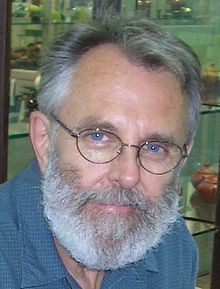Melvyn A. Goodale
| Melvyn Goodale | |
|---|---|

Mel Goodale
|
|
| Born |
Melvyn Alan Goodale January 22, 1943 Leigh-on-Sea, Essex, England |
| Awards | FRS (2013) |
| Scientific career | |
| Fields | Neuroscience |
| Institutions | |
| Website | psychology |
Melvyn Alan Goodale, PhD, FRSC, FRS is a Canadian neuroscientist. He is Director of the Brain and Mind Institute at the University of Western Ontario where he holds the Canada Research Chair in Visual Neuroscience. He holds appointments in the Departments of Psychology, Physiology & Pharmacology, and Ophthalmology at Western. Goodale's research focuses on the neural substrates of visual perception and visuomotor control.
Goodale was born in Leigh-on-Sea, Essex, England in 1943. He emigrated with his parents to Calgary, Alberta, Canada in 1949. He received a Bachelor of Arts degree in Psychology from the University of Alberta at Calgary in 1963 and a Master of Arts degree in Psychology from the University of Calgary in 1966. He left Calgary in 1966 for London Ontario where he completed a PhD in Psychology at the University of Western Ontario in 1969. Goodale then returned to the UK where he was a Postdoctoral Fellow from 1969 to 1971 in the Department of Experimental Psychology at the University of Oxford, under the supervision of Lawrence Weiskrantz. Following his postdoctoral research at Oxford, Goodale accepted a position in the School of Psychology at the University of St. Andrews in Scotland. In 1977, he went back to Canada to take up a position at the University of Western Ontario, where he has remained ever since.
Goodale was a pioneer in the study of the neural substrates of visuomotor control, first in animals and later in humans. Goodale’s early work in the 1980s, in which he demonstrated that visual perception is functionally independent of the visual control of action, laid the foundation for the ‘duplex’ account of high-level vision which he developed later, together with his long-time colleague, David Milner (originally based at the University of St. Andrews but now at Durham University). In a short paper, Goodale and Milner proposed that the distinction between vision-for-perception and vision-for-action could be mapped onto the two streams of visual projections arising from early visual areas in the primate cerebral cortex: the ventral stream which projects to inferotemporal cortex and the dorsal stream which projects to the posterior parietal cortex. This account provides a convincing resolution to conflicting accounts of visual function that has characterized much of the work in the field for the last one hundred years. Over the last decade, Goodale has led much of neuroimaging and psychophysical research that has refined and extended the two-visual-systems proposal. These ideas have had an enormous influence in the life sciences and medicine. The two-visual-systems proposal is now part of almost every textbook in vision, cognitive neuroscience, and psychology.
...
Wikipedia
